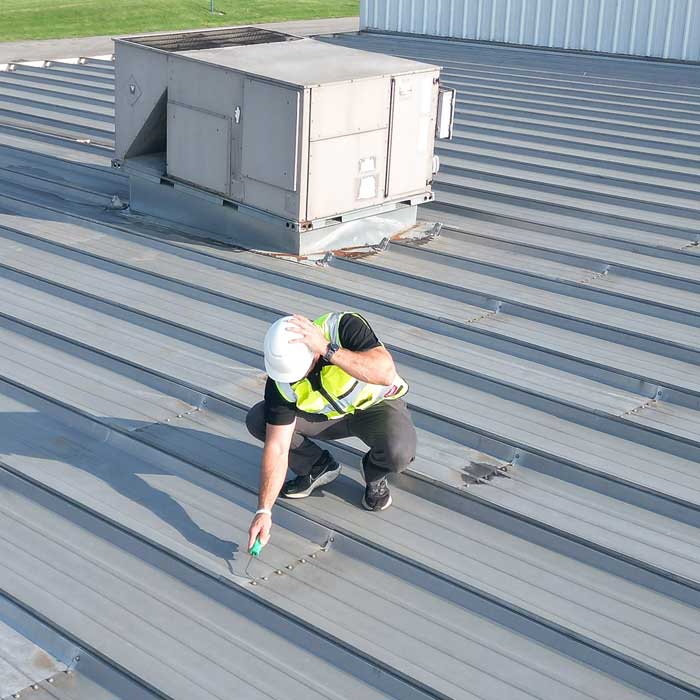We Answer Your Frequently Asked Commercial Roofing Questions!
We’ve compiled a comprehensive list of frequently asked questions that regularly come from our clients. If you can’t locate the answer you’re looking for, don’t hesitate to get in touch with us, and we’ll promptly provide you with a response. Our commitment is to be readily available to assist you and ensure you have an exceptional experience with our commercial roofing services.

Lifespan varies by material but typically ranges from 15 to 50 years.
Regular inspections, at least twice a year, are recommended. solution that can help prolong your roof’s cleanliness.
Yes, many commercial roofs are suitable for solar panel installations.
Signs include leaks, water stains, cracks, and visible wear.
Repairs are possible for specific issues, but replacement may be necessary for extensive damage.
Options include cool roofing materials, insulation, and proper ventilation.
Options include TPO, EPDM, metal, PVC, and modified bitumen.
It depends on local building codes and the existing roof’s condition.
Flat roofs have a slight slope, while pitched roofs have a steeper incline.
Proper drainage systems and regular maintenance help prevent ponding.
Yes, options include green roofs, cool roofs, and recycled materials.
Factors include materials, roof size, accessibility, and labor costs.
Look for water stains, damp spots, or mold growth inside the building.
Insulation provides thermal resistance, energy efficiency, and temperature control.
Repairs are possible but may be more challenging due to weather conditions.
Consider experience, reputation, certifications, and references.
Ventilation prevents heat buildup moisture retention, and extends the roof’s lifespan.
Yes, some regions offer tax incentives or rebates for energy-efficient roofing.
Cleaning frequency depends on location and environmental factors.
TPO is thermoplastic, while EPDM is a synthetic rubber membrane.
Yes, green roofs add insulation and environmental benefits.
It depends on local building codes and the existing roof’s condition.
Contact a professional roofing contractor immediately.
Regular inspections, cleaning, and prompt repairs as needed.
Some financing options are available, and leasing may be an option.
It depends on the roofing material; consult with a professional.
Cool roofing reduces heat absorption, lowers energy costs, and extends roof life.
Work with a knowledgeable roofing contractor familiar with local codes.
Inspect, reinforce, and secure loose items; consider preventive measures.
Yes, a thorough inspection helps identify potential issues and future costs.
Document damage, consult a roofing professional, and contact your insurance provider.
Ponding water, leaks, and membrane damage are common; address promptly.
Yes, with proper planning and structural considerations.
Flashing prevents water infiltration at roof intersections and edges.
Yes, some materials, like metal and certain coatings, are fire-resistant.
Regular inspections and ensuring clear drainage paths help ensure proper drainage.
Yes, with proper installation methods to maintain roof integrity.
Single-ply uses one layer, while multi-ply (built-up roofing) uses multiple layers.
Implement bird deterrents, such as spikes or netting, to prevent damage.
Ventilation prevents heat buildup and moisture issues and extends the roof’s lifespan.
Yes, roof coatings provide added protection and can extend the roof’s life.
Consider energy efficiency, aesthetics, and local climate when choosing colors.
Yes, reflective roof coatings may qualify for tax incentives in some regions.
Identify the source of the leak and repair or replace the skylight as needed.
Warranty coverage varies by material and manufacturer; review terms carefully.
Hiring a professional is recommended for proper installation and warranty coverage.
Implement safety measures, provide training, and use proper personal protective equipment (PPE).
Weather conditions, such as extreme temperatures or storms, may impact scheduling.
Spring and fall are often ideal times for roof inspections to assess winter and summer impacts.
Ready to start roofing? Contact us today to get your free quote!
Stay up-to-date with Kaliber Contracting and the commercial roofing industry.